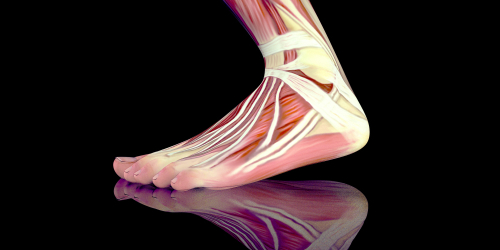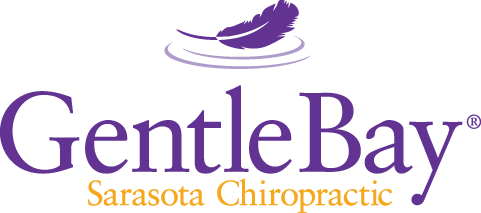Feet are the body’s foundation. We depend on them so heavily, in fact, that persistent foot pain can soon affect day-to-day life. Everyday tasks can seem impossible if strong foot pain is involved. Let’s look at some of the main causes of foot pain and the solutions that can provide relief.

The types of foot pain range from plantar fasciitis or metatarsalgia to Achilles tendonitis or Morton’s neuroma. Some painful feet are arthritic, and others might be painful due to chronic ankle sprain. These are all different problems, but they share one element in common—the inability to handle the normal forces we subject our feet to every day. Causes of this failure include shoes, prior injury, and hereditary problems such as flat feet or high arches.
As many people are aware, the wrong type of shoe can cause foot problems. Long-term wear of high heels often leads to bunions, hammer toes and fallen arches. In addition, slip-on shoes frequently cause toe clenching to keep them from slipping off which can lead to plantar fasciitis. What many people do not know, however, is that just wearing shoes of any kind (even “good” shoes) for a whole lifetime can lead to foot problems.
Three Causes of Foot Pain
Three research studies in different parts of the world that compared barefoot-living villagers with shoe-wearing relatives in cities showed that people who live barefoot have almost no structural foot problems. It turns out that walking barefoot uses more muscular strength in the lower leg which helps to maintain support from tendons that attach from those muscles to the foot. It also stands to reason that people who are inactive or sedentary could be more prone to foot problems due to not insufficient strength in their lower leg muscles.
Another cause of foot pain is past trauma to either the leg or foot. Physical injury can leave residual stiffening and distortion in the connective tissue called fascia. This can, in turn, cause muscular imbalance and weakness that leads to pain—whether it is in the plantar fascia on the bottom of the foot, the pad at the ball of the foot, or the tendon attachment at the back of the heel. In the specific case of chronic ankle sprain, the original injury can cause the ankle to remain weak, so that a person might repeatedly turn their ankle and re-injure it.

Of course, for some people the only cause of their foot pain is they inherited flat feet or abnormally high arches, either of which can lead to extra stress on the foot. With hereditary flat feet, the foot never develops a full arch, so the spring-type shock absorption that the arch of the foot normally provides is diminished. With less spring, there is less protection of the foot from the stresses of walking, running, jumping and standing.
You might think that people with high arches would have opposite issues from flat feet, but actually, a high arch tends to be more rigid (and less springy) than a regularly shaped arch and so puts more stress on the foot when it is bearing weight. In the end, both problems tend to create arch pain.
Answers to Foot Pain
When we look at solutions to foot pain, we should start again with shoes (or the alternative of not wearing shoes at all). While growing up barefoot can be beneficial for your feet, barefoot living will not necessarily help someone who has worn shoes all their life. First, it takes time to build the leg strength to tolerate barefoot walking. A second issue is the hard surfaces that most people tend to live on today. Wood or tile floors, cement sidewalks and asphalt roads are not materials which feet are naturally built for.
For someone who has foot pain, walking on hard surfaces will likely just make things worse. While there are some instances where barefoot walking is helpful—such as on sand or soft earth—most people need shoes for support and protection. The real solution is to wear the type of shoe that will benefit your feet.
While choosing the correct shoe can be complicated, certain basic features are important. The arch should roughly match the shape of your foot. Most people should have at least moderate arch support. People with flat feet should not use too much arch support, although a slight amount is important. Those with high arches usually benefit from a fuller arch support. In many high arch cases, a shoe that is otherwise well built might need either supplemental support or replacement of the built-in support with a deeper arch insert.
Shoes with a sole that is too rigid do not encourage as much leg muscle activity. An ideal shoe must allow flexibility where the toes bend up with also some back and forth twist at the arch. Also, the heel cup should align vertically and not tilt inward. Otherwise the shoe will encourage pronation of the foot and, therefore, foot pain in the long run.
Fascia and Feet
As already mentioned, past physical trauma can leave changes in the fascia (connective tissue) that lead to pain. Manual therapy treatments that release fascia restrictions can help restore muscular balance and joint stability, and this can relieve foot pain. Fascia release is a focus of my practice, and I have helped many people experience relief from foot pain with this type of treatment. In addition to releasing restrictions of the foot tissues, it is also important to release restrictions in the lower legs, thighs and even hips to restore foot function.
It is important to realize just how much fascia can be involved with foot pain. Even when there are physical changes to the foot such as bunions or arthritis, much of the pain is often caused by fascia distortion. Stiffening of this connective tissue can alter muscle tension and joint stability which often helps to cause structural changes like bunions and arthritis.
Treating these restrictions can relieve pain, even though it usually cannot reverse the structural change. Those with naturally high or low arches could develop restrictions in fascia more easily, due to greater stress on their feet. Wearing proper shoes with the right arch supports is critical for these people. When necessary, custom orthotic inserts can be relieving, and fascia release therapy is almost always helpful.
Every case of foot pain is unique, and there is no one-size-fits-all solution. Understanding proper shoe type and arch support is important. In many cases, expert help with fascia release therapy and specific exercise programs make all the difference in achieving pain relief. For those afflicted with pain in the feet, I recommend seeking out a healthcare practitioner experienced in all of the above issues. At our office we provide fascia release therapy, expertise on footwear and orthotic foot support, and when necessary exercise and stretching therapies to help restore healthy foot function and relieve pain.
With the COVID-19 crisis, our evening programs have moved online. You are invited to attend a Zoom webinar on Foot Pain on November 17, 6:30 p.m. You will learn in-depth about causes and treatments for foot pain including important home care. You will also find out more about fascia, why it is important and how fascia problems are involved with foot pain. Dr. Eric Winder will discuss case examples and hold a Q&A session following the presentation. Click here to register for the webinar.



